The railway system in West Wales is a curious mix of single and double track with freight lines. Stuart Warr looks at this pocket of the network that is off the beaten track.
THE three surviving railway lines west of Whitland are largely within the county of Pembrokeshire, a county with a population of 122,400, according to the 2011 Census.
Consequently the populations of its main towns are small. Milford Haven is the largest with 13,907; then Haverfordwest (Pembrokeshire’s county town) with 12,042; and Pembroke Dock – 9,753. There is but one city in the county, St Davids, status granted not as a result of its population (1,841) but by virtue of its fine cathedral.
Pembrokeshire is noted for its oil and gas production, agriculture and tourism. At its peak there were five refineries all situated around the deep-water facilities at Milford Haven and Pembroke Dock. The sale of the Murco site to Puma Energy in March 2015 will lead to the site at Robeston being used as a storage facility, leaving just one active refinery.
Monthly Subscription: Enjoy more Railway Magazine reading each month with free delivery to you door, and access to over 100 years in the archive, all for just £5.35 per month.
Click here to subscribe & save
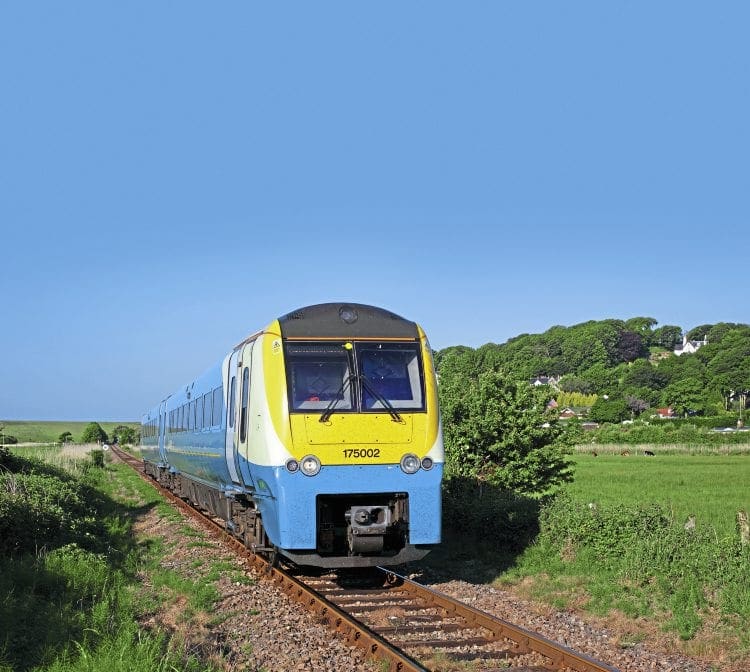
Being situated in the south-west of Britain, and having a mild climate, agriculture is important to the economy of the county with a mix of arable and non-arable production. Pembrokeshire new potatoes have protected geographical status and are often on sale earlier than similar potatoes from other areas of Britain; barley and oilseed rape are other important arable crops grown here.
Non-arable produce includes dairy (for milk and cheese), beef production and sheep farming.
Tourism is arguably Pembrokeshire’s biggest contribution to employment and wealth production; in 2011 it contributed almost £570million to the economy and gave the equivalent of 14,180 direct full-time jobs with an additional 2,085 indirectly supported. Tenby is the best known of Pembrokeshire’s traditional holiday resorts, but in addition the county has a number of Blue Flag Awards for its beaches and the Pembrokeshire Coast National park is highly regarded.
The early history and ownership of lines currently open will be considered as each line is analysed, but to summarise more recent events, by the time of the Grouping all lines were under the auspices of the Great Western Railway. Nationalisation saw that responsibility passed to the Western Region of British Railways (BR). Sectorisation then placed these lines under Regional Railways.
Privatisation started with Wales & West (1996-2001), Wales & Borders (2001-2003), with Arriva Trains Wales (ATW) being awarded the franchise for 15 years from 2003. This company operates the majority of passenger services west of Whitland, the exception being Great Western Railway’s (formerly known as First Great Western) summer-dated, Saturdays-only services to/from Pembroke Dock, with one service working in from Swansea and the other from Paddington, both returning to London.
Today’s services are usually made up of two- and three-car units, primarily from ATW’s fleet of Class 150s and 175s. The summer-dated services operated by Great Western Railway are standard formation HSTs.
The closed line with the greatest former importance is the one that led to Neyland, the closed section being fairly short (about five miles) from Old Milford Branch Junction, immediately south of Johnston on what is now the Milford Haven branch.
In 1856, Neyland became the western terminus of Isambard Kingdom Brunel’s South Wales Railway. It was initially leased to the Great Western Railway and in 1863 the two railways amalgamated.
It was built with the primary use of being a transatlantic terminal for the largest ships of the time and as a consequence the town grew rapidly. In 1906 a new and more substantial port opened – Goodwick, now known as Fishguard Harbour – leading to the transfer of the invaluable Irish traffic, and may be considered as the time when Neyland’s importance started to decline. However, it was 1964 before the by now much-reduced station and branch were closed.
‘Cardi Bach’
In 1966 the branch reopened temporarily in connection with the building of the new Gulf oil refinery, finally closing some three years later. The summer 1959 edition of British Railways’ Western Region timetable shows on weekdays five trains from and two through to Paddington with five outbound workings (two for Bristol Temple Meads, two for Milford Haven and one for Johnston) and four inbound (one each from Swansea, Bristol Temple Meads, Milford Haven and Johnston). The site of Neyland station now forms part of a marina.
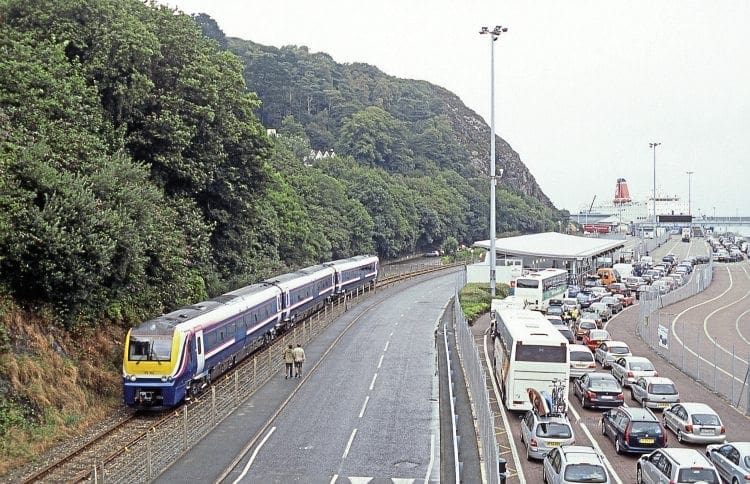
A little to the west of Whitland was Cardigan Junction with a branch to the eponymous Cardigan, about 27 miles in length. Known to one and all as the ‘Cardi Bach’ its closure to passengers in 1962 was prior to the publication of the infamous Beeching Report. The branch lingered on afterwards for a while for coal and freight. It had a limited service, for example in the summer of 1959 on weekdays there were four services to Cardigan and three back to Whitland.
Part of the trackbed is now a footway and cycle path through Teifi Marshes and Wildlife Park.
Traffic decline
Before the opening of the ‘direct’ route to Fishguard Harbour in 1906 there was a circuitous route from Clynderwen through Rosebush and Letterston to Fishguard; after the opening of the ‘direct’ route traffic declined with the passenger service ceasing in 1937, closing completely between Clynderwen and Letterston some 12 years later.
However, the stub from the latter-named village to Trecwn Junction remained open to freight traffic until March 1965; Letterston Junction to Trecwn Junction and on to Trecwn remained open until the mid-1990s.
The line to Trecwn has an interesting history, being opened in 1899 to serve an army camp, which was utilised as an isolation hospital during the Boer War and the First World War. Later, an armament depot was established here, initially for use during the Second World War, and an extensive narrow gauge railway was built within the depot with exchange sidings for transfers between it and the national network.
In 1997 the depot was sold by the Ministry of Defence for private use and there have been a number of proposals subsequently to establish freight distribution centres, all of which have come to nought. The Trecwn branch, however, is currently classified as ‘out of use’ so there is still some hope that proposals to establish some form of distribution centre may be re-kindled.
Whitland to Pembroke Dock
Of the three remaining passenger-carrying lines open I will firstly consider the Pembroke Dock branch followed by the branch to Milford Haven, and finally the line down to Fishguard Harbour.
The logical starting point is Whitland, situated just over the county boundary in Carmarthenshire; this small town found itself on the proposed route of the South Wales Railway (SWR) projected in 1844 from the Great Western Railway (near Gloucester) to Fishguard, with a branch from Whitland to Pembroke.
It was to be engineered by Isambard Kingdom Brunel and, as might be expected, built as a broad gauge railway, but financial difficulties and the Irish potato famine brought about amendments to the plans; these will be considered in more detail later in the article.
Whitland’s broad gauge station opened on January 2, 1854; in 1858 Parliament refused to renew the SWR’s powers for its branch from here to Tenby and Pembroke, something that encouraged local enterprise to make their own arrangements to be connected to the outside world.
The Pembroke & Tenby Railway (P&TR) was incorporated by an Act of July 21, 1859, and opened as a standard gauge line on
July 30, 1863 between the two places named in the Act. An extension to Pembroke Dock opened on August 8, 1864, by which time powers had been secured to reach Whitland, which opened on September 4, 1866 at a station next to that of the broad gauge line.
Of interest is that one of the contractors who had driven the building work through hilly country with such energy was David Davies, later to become the ‘father’ of the Barry Dock & Railway Company.
The SWR was leased to the Great Western until 1863 when they amalgamated; the P&TR threatened the GWR that if a standard gauge line was not laid down between Whitland and Carmarthen, it would build its own line. Following negotiations the GWR acceded to these demands and by 1869 the two companies operated from the same Whitland station, with the P&TR using the eastbound line, which had been re-gauged.
By 1872 the broad gauge main-line had been converted to standard gauge and from then the GWR operated P&TR services east of Whitland, but it was 1896 when the P&TR was absorbed fully by its larger neighbour.
To finalise the railway origins of this small town, it was in 1873 that the first section of the Cardigan branch was opened by the Whitland & Taff Vale Railway Company, with the GWR taking over the operation of the line. The opening of the final extension to Cardigan in 1886 and full absorption by that railway came in 1890.
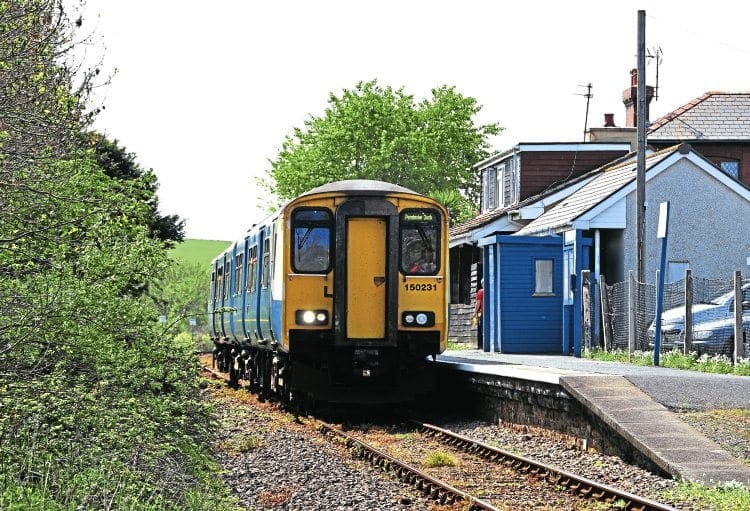
Important junction
Whitland became an important junction with an appropriately large running-in board announcing ‘Whitland – Junction for Pembroke & Tenby and Cardigan branches’, and around the station as traffic increased so did its facilities with quite extensive sidings, a goods shed and an engine shed. The latter was coded WTD by the GWR and sub to 87H, later 87H under British Railways (BR) until closure in 1966.
In 1947, Whitland had a total of 19 locomotives allocated. Improvements to the station were made in 1939 with major rebuilding in 1958 and as subsequent years have passed and staffing levels reduced it no longer appears as a welcoming place to await a train; the up platform (towards Swansea) has a boarded-up building with no waiting room or toilets and on the down side there is a bus shelter-style waiting room that provides little protection from the elements.
Just three platforms remain. The one on the down side is an island platform with an infrequently used bay once regularly used for services to and from Pembroke Dock that do not originate or terminate east of Whitland. Freight no longer emanates from west of Carmarthen other than the oil tankers from Robeston to Westerleigh/Theale, to be considered later in this article. A signalbox remains at Whitland next to the level crossing immediately to the east of the station. It was installed in 1972 having been moved from Danygraig (Swansea).
The line from Whitland to Pembroke Dock is about 27 miles long and single throughout, with a passing loop at Tenby and a siding at its western extremity. There are eight intermediate stations, with Tenby arguably being the most important. It serves the best known seaside resort in South Wales with glorious beaches and a host of other family holiday-orientated attractions.
Former glory
The station appears to retain some semblance of its former glory with buildings on the platforms that are Grade II listed, and despite the relative lack of maintenance in recent years, it still looks impressive. In its heyday Tenby had (in addition to its current two platforms) a passing loop and a bay.
Pembroke Dock station was an important terminus with services primarily aimed at the longer distance traveller. For example, the summer 1959 timetable shows seven weekday outbound workings (three to Paddington, one each to Swansea and Carmarthen and two to Whitland); in the reverse direction nine workings (seven from Paddington and two from Whitland).
Facilities included a small engine shed (a sub shed to Whitland throughout its existence until closure in 1963) and a goods yard; lines extended through the station to serve the dockyard.
The equivalent service – summer 2015 weekdays – shows nine outbound (one each to Gloucester, Cardiff and Carmarthen and six to Swansea) with nine inbound (one each from Manchester Piccadilly and Cardiff, three from Carmarthen and four from Swansea).
At first glance the service appears comparable, but it must be borne in mind that in 1959 the majority of services involved a locomotive and several coaches, whereas now most services are in the hands of two-car Class 150s. Each day there are two departures from the ferry port to Rosslare, but it is a bit of a walk from the railway station. There is no connection with the overnight ferry and only a tenuous link with the daytime one. In terms of rail usage in connection with the ferry service the Fishguard Harbour service is undoubtedly the obvious one. The last regular freight workings on the branch conveyed domestic coal to Pembroke Dock, but these ended in 1978.
It would not be untrue to suggest that this line clings to life, no stations are staffed, only a couple have ticket machines and passenger usage follows no trends with some stations showing increases in recent years and others decreases.
Whitland to Milford Haven
Noted earlier the SWR had plans in 1844 to build a line through Whitland to Fishguard. A branch to Haverfordwest was also proposed, but the Irish potato famine and financial difficulties saw those plans forsaken in 1851 west of Clarbeston Road in favour of extending the Haverfordwest branch to Neyland.
An Act dated June 5, 1856 incorporated The Milford Railway Company (MRC), with plans to build a broad gauge line about four miles long from Milford Haven to a junction with the Neyland branch at Johnston. Opened on September 7, 1863 it was worked by the GWR, the MRC being absorbed fully in 1896. The broad-gauge tracks were converted to standard gauge in 1872 and in its heyday the line from Whitland to Johnston was double track, but in 1988 it was singled west of Clarbeston Road at the same time the branch was re-signalled, with control from the ’box at that station.
Travelling west from Whitland to Milford Haven there are four intermediate stations situated at Clynderwen, Clarbeston Road, Haverfordwest and Johnston. Of these, Haverfordwest and Milford Haven have the largest populations and consequently the best rail services.
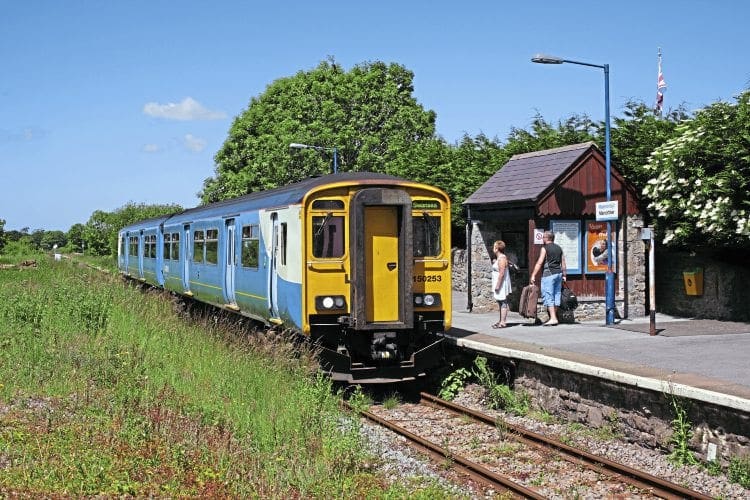
Haverfordwest is the biggest station west of Whitland, having been reconstructed between the two world wars. It had up and down goods loops and a large goods and coal yard on the down side. In 1982 the buildings (including the ticket office) on the up side were modernised, and 2002 brought a refurbishment to provide a welcoming entrance to the station and an interchange with some local bus services.
Semi-derelict
Freight to and through Haverfordwest started to decline in the late 1960s except for the oil tanker trains working to and from the refineries at Milford Haven, rail links having been constructed during that decade from the branch to the refineries at Waterston and Robeston/Herbrandston. In 1988, during the singling and re-signalling work, the up goods loop was removed and much of the goods yard became semi-derelict, but for the occasional stabling of crippled oil tankers and the annual Rail Head Treatment Train.
Milford Haven was an important terminus, serving as it did the biggest town in Pembrokeshire, its dockyard and fish-dock; the station expanded as traffic grew with lines passing through and round the station to the docks.
The summer 1959 timetable shows nine weekday arrivals (five from Paddington, with one each from Carmarthen, Llanelli, Swansea and Bristol); the same timetable shows a similar number of departures (six to Paddington, two for Carmarthen and one for Clarbeston Road). The weekday timetable for summer 2015 shows a few more services, but with a different emphasis on destination/starting point as a direct result of the geographical limitations of the franchise holder; there were 11 arrivals and departures (six from Manchester, two each from Carmarthen and Cardiff, with one from Newport; six to Manchester, three to Carmarthen and two bound for Cardiff).
Visiting excursions
In 1988 the singling and re-signalling exercise reduced the layout considerably with much of the former goods yard and dock lines derelict, though some freight continued into the 1980s. The station area now looks improved upon when compared to just a few years ago. All that remains is the single curved platform complete with the privately run ticket office and a rudimentary shelter.
There is a siding next to the station. It is used rarely, but has on occasions been a refuge for visiting excursions, allowing the station to continue to function. To the west of the station is a retail park situated on sidings and lines down to one of the docks; a large car park is sited on the equivalent land to the east of the station.
Most current services are diagrammed for two- or three-car Class 175s, an acceptable modern unit for longer distances such as those from here to Manchester; connections at Swansea allow passengers to easily get to London and the South East.
Freight is much reduced on the branch currently. There used to be workings supplying coal and merchandise for the town as well as for the docks, with imported freight moved in the opposite direction, including three daily fish trains (until the late 1940s) with some travelling as far as London. Since the early 1960s the produce of the refineries has been taken by train from this area; Herbrandston Junction (south of Johnston) led to the refineries at Robeston and Herbrandston, opened in 1964 and 1960, respectively.
Between Johnston and Hebrandston Junction is Gulf Oil Junction, which led down to Waterston refinery, opened in 1968. Oil refining has declined in the area with the last rail-based refinery ceasing work in March 2015 when the Murco plant at Robeston was sold to Puma Energy, a company that stores and distributes its refined products by rail with, in a typical week, two trains to Theale and three or four to Westerleigh. Most current movements, both in and out, occur during the night so as not to cause timetabling problems for the passenger workings.
Whitland to Fishguard Harbour
Earlier, I examined the line from Whitland to Milford Haven which, as far as Clarbeston Road, is shared with the current route to Fishguard Harbour; I also commented on the first line to Fishguard from Clynderwen (via Rosebush) and how it went into decline with the opening of the direct route from Clarbeston Road.
The motivation to construct a more direct line westwards to the then terminus at Fishguard & Goodwick (effectively the ‘town station’ for Fishguard) and beyond to the harbour came about as the result of negotiations and an agreement between three parties: the Fishguard & Rosslare Company (F&R), the Great Southern & Western Railway (GS&WR) of Ireland, and the GWR.
The F&R obtained powers to complete harbours at both Fishguard and Rosslare; the GWR would manage steamers provided by the F&R and work the harbour and railways on its side of the channel; and the GS&WR would do so in Ireland.
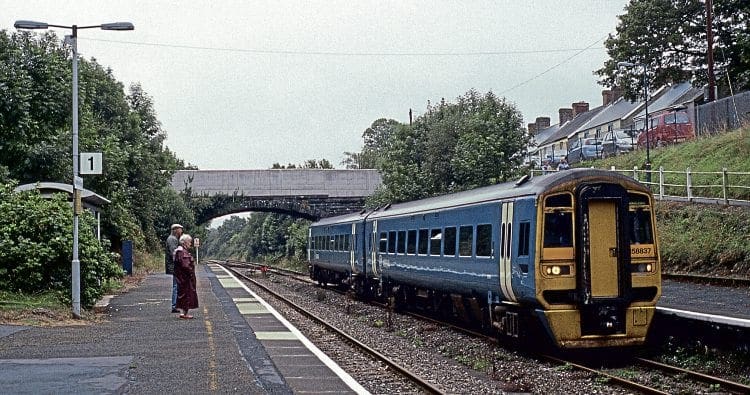
In 1898 the GWR obtained powers to construct a direct line from Clarbeston Road to Letterston Junction, around 10½ miles in length. At Letterston Junction it joined the original line down to Fishguard (the North Pembrokeshire & Fishguard Railway) from where it would extend by about 64 chains (around 1,400 yards) to the harbour. The route to be built was through heavily undulating ground and included Spittal tunnel, at 242 yards in length on a falling gradient of 1-in-110 westbound.
From Letterston Junction the pre-existing line fell westbound at 1-in-50/60 into Fishguard. Difficult though that construction was the building of the quay and breakwater greatly overshadowed it; equipment had to be taken by cart from Letterston and lowered down the cliff face to the work site and two million tons of material were excavated. Extensive sidings and cattle docks were provided in addition to the four platforms initially constructed, and close to the station at Fishguard & Goodwick an engine shed was built.
Ferry service
The Clarbeston Road to Fishguard Harbour officially opened on August 30, 1906 and the ferry service to Rosslare started on the same date. This brought about a reduction in the sea passage (Neyland, then known as New Milford to Waterford) from 98 miles to 54.
The GWR promoted its service from Paddington with a boat train departing at 8.45am, advertised to stop only at Cardiff and scheduled to arrive at its new western terminus at 2.20pm, with the steamer arriving in Rosslare at 5pm.
The ambition of the GWR for Fishguard Harbour was for it to be a stopping place for the transatlantic ships as it was the nearest of the competition (Plymouth and Southampton) to New York. A number of shipping lines utilised the port, including Cunard, but there were several serious problems such as the inability of the bigger ships (e.g RMS Mauretania) to berth alongside. Tenders had to be used to disembark passengers and mail; powers being obtained in 1908 to build an additional breakwater with an ‘Ocean Quay’ at which the biggest ships could berth alongside. Improvements to the infrastructure helped the GWR move heavy trains more quickly to and from the port, the best known being the opening in 1912 of the Swansea District Lines that afforded easier grades for services not scheduled to call at Swansea.
Abandoned plans
Further expansion was planned to aid speeding up these services, including the authorisation in 1914 of 8½ miles of new line between Llangennech and Pembrey to avoid the congested Llanelly (as it was then spelt). However, the First World War brought about the end of the plans to further capitalise on the transatlantic trade. By around the time of the Grouping the troubles in Ireland brought about a 12-month break in ferry services, and it was about this time that the GWR abandoned the new up line out of Fishguard, for which powers had been obtained in 1908.
Several stations existed between Clarbeston Road and Fishguard Harbour. All closed to passengers on April 6, 1964, though Motorail services continued to use Fishguard & Goodwick until 1980 when it ceased running services to west Wales. Following surveys and reports the latter-named station reopened on May 14, 2012 when the number of passenger services between Fishguard Harbour and Clarbeston Road increased from two in each direction to seven without recourse to additional coaching stock, ATW having re-shuffled their service diagrams accordingly.
When built Fishguard Harbour was well-blessed, with both sidings and platforms, but now a little more than 100 years since opening its use has declined in much the same manner as the other two branches in west Wales.
No freight
There is now no freight, but (for example) in 1970 there were three departures (one to Paddington Goods and two to Margam) and two arrivals (both from Margam).
The track layout has contracted considerably and there is but one platform. It has a run-round loop, but it is out of use; all the land formerly occupied by railway lines is now used by road hauliers and cars/coaches for the twice-daily ferry service.
With reference to the timetable for the summer of 1959, on weekdays there were 12 inbound passenger services (seven from Clarbeston Road, three from Paddington and one each from Weston-super-Mare and Birmingham Snow Hill); in the opposite direction were nine services (five to Clarbeston Road, three to Paddington and one to Carmarthen). The equivalent timetable for the summer of 2015 shows seven services in each direction (inbound reveals two each from Clarbeston Road and Swansea and one each from Gloucester, Carmarthen and Newport; outbound has two each to Clarbeston Road and Carmarthen and one each to Swansea, Cardiff and Manchester).
No longer is there a direct train to/from Paddington, but services that serve the two daily ferry sailings connect with trains to/from London. The two services in each direction between Clarbeston Road and Fishguard Harbour connect with trains to/from Milford Haven and the east.
Traditionally the movement of the great British public to and from their chosen holiday destinations required additional trains when compared to the weekday timetable. There is insufficient space to review these in depth and over a long period, but I will recall my own memories of the workings west of Whitland.
Summer Saturdays
I first came to live in South Wales in the early 1970s and spent many happy hours watching and photographing trains on Saturdays during the summer. A typical day might produce (in each direction) a couple of Class 47-hauled trains from Paddington to Pembroke Dock, another Class 47-hauled train from York to Tenby, a Paddington to Fishguard Harbour service, often with a relief train, and a Kensington Olympia to Fishguard & Goodwick Motorail service again, often with a relief working.
The Fishguard services could be handled by either a Class 47 or a Class 52; most trains on all of these services usually had at least nine-coaches, with the Motorail loading up to 13 coaches.
How I wish for a time-machine!
For a sparsely populated area there is evidence to show that the indigenous population and its visitors are quite well served by the current railway timetable.
The influence of such bodies as the Welsh Government has brought improvements (such as the reopening of Fishguard & Goodwick and the additional services on that branch), and on the other two branches both franchisees are required to maintain services to a specified level.
Subsidies are required from the public purse to keep the current service level. If these subsidies were not forthcoming there is much local speculation that services would be withdrawn and ultimately line closures. If this were to happen Pembrokeshire would suffer financially, not only because of a reduction in tourism, but a reduction in the mobility of the residents of the county.
Wales is already a financially impoverished region where house prices and salaries are below the average of many other areas in the United Kingdom. The knock-on effect to the county that is the farthest south-west from Cardiff, the Principality’s capital, is potentially devastating. ■
Read more News and Features in the August issue of The RM – on sale August 2




